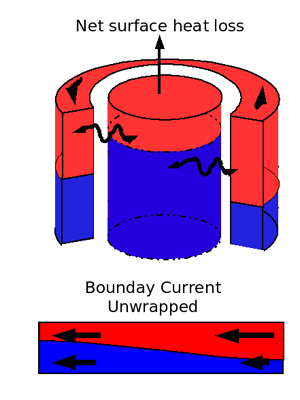 |
 |
||||||||||||||
Convection, Sinking and the Poleward Heat Transport
|
|||||||||||||||
 |
Schematic of a two layer model that represents dense water
formation in a marginal sea. The interior is a region of
net heat loss and of dense water formation - thus maintaing
a reservoir of dense fluid. The boundary current that flows around it
exchanges heat with the interior (via instability processes) and becomes
progressively colder. A net sinking and associated barotropization of
the flow are associated with the boundary current transformation. |
To learn more about this:
short: Straneo, F., 2005, Dense Water Formation and Overturning: What is the Connection?
presented at European Geophysical Union 2005
longer: Straneo, F., 2005, On the connection between convection and sinking and its implication for overturn variability.
presented at the Potsdam Institute for Climate Impact Research, May 2005
long: Straneo, F., 2006, On the connection between dense water formation, overturning and its implication for overturning variability. J. Phys. Ocean. 36(9), 1822-1840.
short: Straneo, F., 2005, Dense Water Formation and Overturning: What is the Connection?
presented at European Geophysical Union 2005
longer: Straneo, F., 2005, On the connection between convection and sinking and its implication for overturn variability.
presented at the Potsdam Institute for Climate Impact Research, May 2005
long: Straneo, F., 2006, On the connection between dense water formation, overturning and its implication for overturning variability. J. Phys. Ocean. 36(9), 1822-1840.
| PO Homepage | WHOI Homepage |